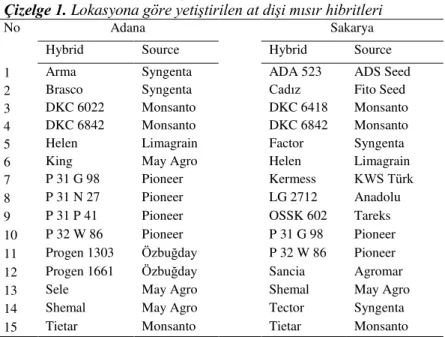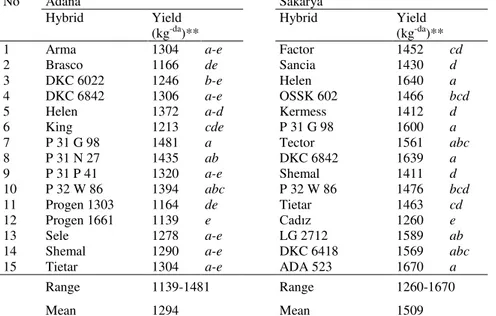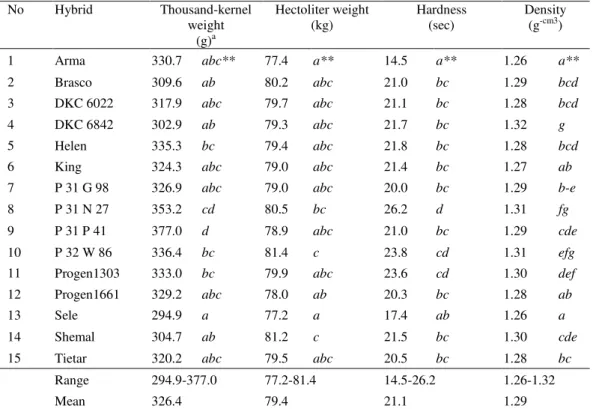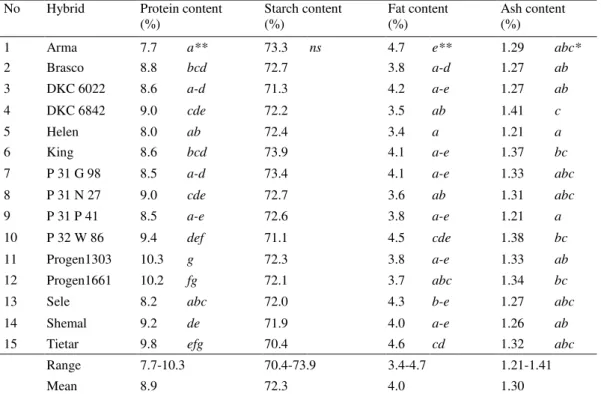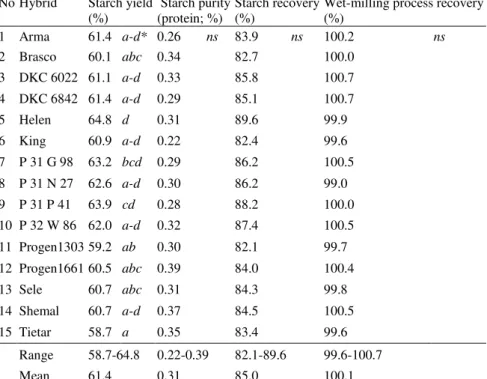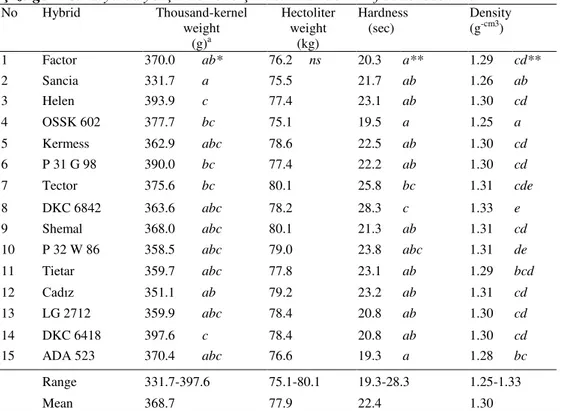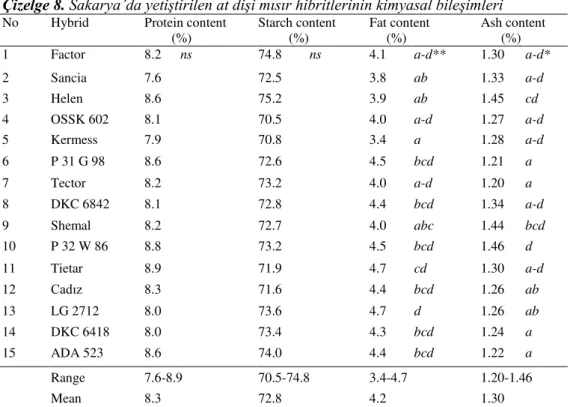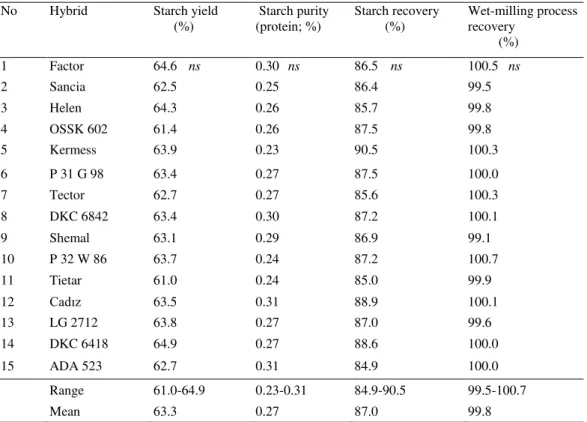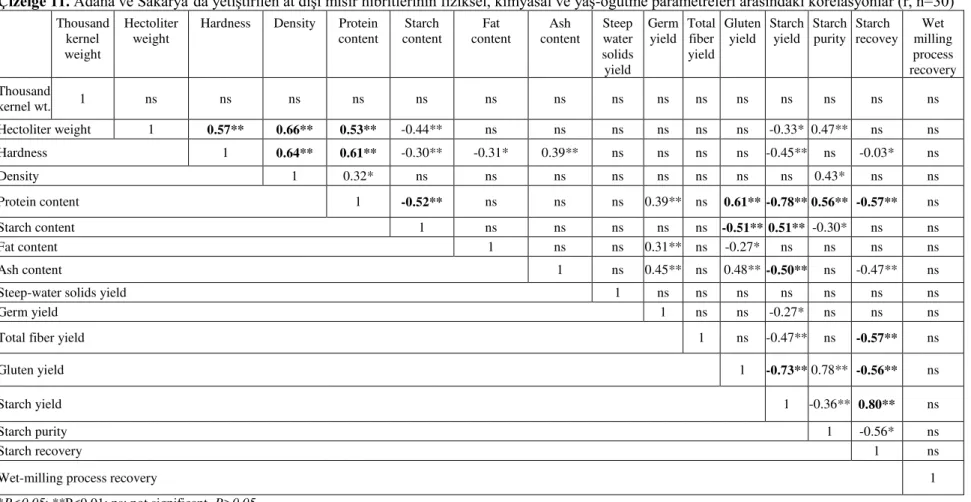Journal of Agricultural Faculty of Gaziosmanpasa University http://ziraatdergi.gop.edu.tr/
Araştırma Makalesi/Research Article
ISSN: 1300-2910 E-ISSN: 2147-8848 (2016) 33 (3), 167-180 doi:10.13002/jafag1144
Wet-Milling Qualities of Dent Corn (
Zea mays indentata L.) Hybrids Grown as Main
Crop in Adana and Sakarya
Abdulvahit SAYASLAN
1*
Rüveyda EROL MERCAN
2Ahmet DUMAN
3Mehmet Ali S
AKİN
41Karamanoğlu Mehmetbey University, Faculty of Engineering, Department of Food Engineering, Karaman 2
Ministry of Food, Agriculture and Livestock, Rize Food Control Laboratory, Rize
3Ministry of Food, Agriculture and Livestock, Maize Research Institute, Sakarya 4Gaziosmanpaşa University, Faculty of Agriculture, Department of Field Crops, Tokat
*e-mail: sayaslan@kmu.edu.tr
Alındığı tarih (Received): 10.11.2016 Kabul tarihi (Accepted): 07.12.2016 Online baskı tarihi (Printed Online): 12.12.2016 Yazılı baskı tarihi (Printed): 30.12.2016
Abstract: Although dent corn (Zea mays indentata L.) production has steadily increased in Turkey, limited research has been conducted on suitability of corn hybrids for starch production, i.e., wet-milling quality. This research was therefore conducted to determine physical properties (thousand-kernel weight, hectoliter weight, hardness and density), chemical compositions (protein, fat, ash and starch contents) and wet-milling quality parameters (steep-water solids, germ, gluten, total fiber, starch yields, etc.) of dent corn hybrids grown as the main crop in Adana and Sakarya. Corn hybrids grown in Adana revealed significant differences in their physical, chemical and wet-milling properties. The hybrids Helen, P 31 P 41, P 31 G 98, P 31 N 27 and P 32 W 86 were found to have superior wet-milling qualities. The hybrids grown in Sakarya also exhibited significant differences in certain physical and chemical parameters, yet they did not differ significantly in starch yield, recovery and purity, inferring their similar wet-milling qualities. Additionally, positive correlations of hectoliter weight with hardness, density and protein content, negative correlations of protein content with starch content, yield and recovery, positive correlation of starch content with starch yield were of noteworthy.
Keywords: Corn, maize, starch, quality, wet-milling, Zea mays indentata
Adana ve Sakarya’da Birinci Ürün Olarak Yetiştirilen At Dişi Mısır
(
Zea mays indentata
L.) Hibritlerinin Yaş-Öğütme Kaliteleri
Öz: Türkiye’de at dişi mısır (Zea mays indentata L.) üretiminin sürekli artışına rağmen, mısır hibritlerinin nişasta
sanayine uygunluğu (yaş-öğütme kalitesi) hakkındaki araştırmalar sınırlıdır. Bu araştırma, Adana ve Sakarya’da birinci ürün olarak yetiştirilen mısır hibritlerinin fiziksel özellikleri (bin tane ağırlığı, hektolitre ağırlığı, sertlik ve yoğunluk), kimyasal bileşimleri (protein, yağ, kül ve nişasta) ve yaş öğütme parametrelerini (ıslatma suyuna geçen kuru madde, embriyo, gluten, toplam lif, nişasta verimleri vb.) belirlemek amacıyla yürütülmüştür. Adana’da yetiştirilen mısır hibritleri fiziksel, kimyasal ve yaş öğütme özellikleri bakımından önemli farklılıklar göstermiştir. Helen, P 31 P 41, P 31 G 98, P 31, N 27 ve P 32 W 86 hibritleri, üstün yaş öğütme özelliklerine sahip bulunmuştur. Sakarya’da yetiştirilen mısır hibritleri de bazı fiziksel ve kimyasal özellikler bakımından farklılık göstermiştir; ancak nişasta verimi, randımanı ve saflığı bakımından farksız bulunmuştur. Bu durum yaş öğütme özelliklerinin benzer olduğunu göstermektedir. Ayrıca, hektolitre ağırlığı ile sertlik, yoğunluk ve protein içeriği arasındaki pozitif korelasyonlar, protein içeriği ile nişasta içeriği, verimi ve randımanı arasındaki negatif korelasyonlar, nişasta içeriği ile nişasta verimi arasındaki pozitif korelasyon önem arz etmektedir.
1. Introduction
Maize or corn (Zea mays L.) is the leading cereal grain in the world with an annual production of about one billion tons in 2014 (FAO, 2016). Corn production in Turkey follows wheat and barley, although it has steadily increased to almost 6 million tons in recent years (FAO, 2016). Among the cultivated corn types, dent corn (Zea mays indentata L.) constitutes the major percentage of world production. Adana and Sakarya, having respectively about 30% and 20% shares, are two major corn producing provinces in Turkey. Even though production amounts of corn and corn starch have increased in recent years, research on suitability (wet-milling quality) of corn hybrids grown in Turkey for starch production is rather limited. Apart from this work, one doctoral dissertation that was partially accomplished in our laboratory is available (Özsisli, 2010), in which wet-milling qualities of dent corn hybrids grown as main or second crop were compared.
Wet-milling is defined as aqueous separation process of starch and other valuable components from starch-rich materials (Sayaslan, 2004). Commercially, corn, wheat, potato and tapioca (cassava) are used in wet-milling to produce starch (Sayaslan and Gökmen, 2008). Corn starch constitutes more than 80% world total starch production. Upon wet-milling of corn, five fractions are obtained; namely starch (60-70%), gluten/protein 15%), fiber (10-15%), germ (5-10%) and steep-water solids (5-8%) (Watson, 1984; May, 1987; Singh, 1999; Eckhoff, 2004). Assessment of corn wet-milling quality is based mainly on the yield, recovery and purity of starch fraction (Hellevang and Wilcke, 1996; Eckhoff, 2004; Morris, 2004). In Turkey, there are seven large-scale wet-milling plants, all of which process only dent corn for starch production (Sayaslan and Gökmen, 2009). Starch and its derivatives have been mainly used in food industry (Seib, 1994; Maningat and Seib, 1997; Bergthaller, 2004; Sayaslan, 2004); however, their usage has recently increased in bioethanol, bioplastics and other chemical industries
(Maningat and Bassi, 2004; Feige, 2007; Sanderson, 2007; Witt, 2007).
Corn wet-milling quality is influenced by the genotype (corn type and hybrid), growing conditions and postharvest treatments such as transportation, drying and storage (Singh, 1999; Eckhoff, 2004). In terms of corn type, dent corn is best suited for wet-milling due to its higher starch content that increases starch yield. Additionally, softer endosperm texture of dent corn facilitates ease of separation, which increases starch recovery (Fox et al., 1992; Hellevang and Wilcke, 1996; Singh, 1999; Eckhoff, 2004). Wet-milling quality of dent corn also differs by hybrid. In this regard; kernel size (thousand-kernel weight) and grain hardness are key variables influencing wet-milling characteristics of hybrids. Larger kernels contain more endosperm and thus higher level of starch, leading to increased starch yield in wet-processing (Fox et al., 1992). On the other hand, harder kernels commonly have higher density and protein content sand lower starch contents, resulting in lower starch recovery (Hellevang and Wilcke, 1996; Eckhoff, 2004. It was reported however that differences in kernel size and hardness, both affected by genotype and environment (Sing, 1999; Rooney and Suhendro, 2001), explained only 40 to 50% of variation in wet-milling qualities of corn hybrids (Jackson, 1996). It is well-known that there are unexplained variations in the wet-milling qualities of corn hybrids with similar physical properties and chemical compositions; it is therefore essential to employ laboratory-scale wet-milling tests to differentiate processing qualities of different corn hybrids grown in diverse environmental conditions. Indeed, in a six-year study conducted in the USA, starch yields of commercially produced dent corn hybrids were found to vary from 50 to 72% (Eckhoff, 2004; Morris, 2004).
Postharvest treatments such as transportation, drying and storage affect wet-milling quality of corn (Hellevang and Wilcke, 1996; Singh et al., 1998a and 1998b; Eckhoff, 2004). Corn kernels exposed to excessive mechanical forces during improper harvest, transportation and drying can cause cracking of kernels, which elevates loss of
corn solids during steeping and reduces wet-milling quality (Wang and Eckhoff, 2000; Mbuvi and Eckhoff, 2002). Also, drying of corn over 55ºC for extended period was found to strengthen protein-starch interactions in the endosperm and to intensify rubbery structure of germ, both of which reduced the wet-milling quality of corn (Mistry et al., 2003; Morris, 2004; Eckhoff, 2004).
Given the facts that corn and corn starch productions have been increasing in Turkey and that limited research is available on their wet-milling qualities, the purpose of this study was therefore to investigate the physical properties,
chemical compositions and wet-milling qualities of corn hybrids grown as the main crop in Adana and Sakarya, two diverse climatic regions of Turkey.
2. Materials and Methods
2.1. Materials, locations and experimental approach
Dent corn hybrids used in this study (Table 1) were grown as main crop in Adana (Agricultural Research Field of Çukurova University) and Sakarya (Agricultural Research Field of Maize Research Institute) with three replications in 2008 and 2009 growing seasons.
Table 1. Dent corn hybrids grown by location
Çizelge 1. Lokasyona göre yetiştirilen at dişi mısır hibritleri
No Adana Sakarya
Hybrid Source Hybrid Source
1 Arma Syngenta ADA 523 ADS Seed
2 Brasco Syngenta Cadız Fito Seed
3 DKC 6022 Monsanto DKC 6418 Monsanto
4 DKC 6842 Monsanto DKC 6842 Monsanto
5 Helen Limagrain Factor Syngenta
6 King May Agro Helen Limagrain
7 P 31 G 98 Pioneer Kermess KWS Türk
8 P 31 N 27 Pioneer LG 2712 Anadolu
9 P 31 P 41 Pioneer OSSK 602 Tareks
10 P 32 W 86 Pioneer P 31 G 98 Pioneer
11 Progen 1303 Özbuğday P 32 W 86 Pioneer
12 Progen 1661 Özbuğday Sancia Agromar
13 Sele May Agro Shemal May Agro
14 Shemal May Agro Tector Syngenta
15 Tietar Monsanto Tietar Monsanto
Instead of choosing the same genotypes in both locations, the genotypes that were widely cultivated in each location with higher economic value were included in the study. Furthermore, hybrids were chosen from as many seed companies as possible to practically avoid genotypes with similar backgrounds.
Adana is located in the Mediterranean region with an altitude of 33m, while Sakarya in the West Black Sea region with an altitude of 31 m. During the growth seasons of 2008 and 2009, both locations had their typical climate conditions. Mean temperatures of Adana from April to October in 2008 and 2009 growth years
were respectively 21.1 and 19.7 0C, whereas 20.8 and 20.9 0C in Sakarya during the same period. Total rainfall from April to October for 2008 and 2009 growing seasons were respectively 58.7 and 82.9 mm in Adana and 295.5 and 287.4 mm in Sakarya (MGM, 2016). Both locations had clay-loam soil characteristics with pH ranging from 7.49 to 7.89 and organic matter from 0.91 to 1.87%.
Dent corns hybrids were planted with three replications in each location for two years by the randomized complete block design. Each plot was consisted of 39.2 m2 (7.0 m x 5.6 m) of area containing eight rows. Depending on soil analyses
of the locations, nitrogen and phosphorus fertilizations, based respectively on 20 kg-da and 7 kg-da, were applied. Conventional tilling, husbandry, irrigation, plant protection and related technical works were carried out by Kırtok (1998).
2.2. Physical properties
Test (hectoliter) weights and thousand-kernel weights of corn hybrids were measured as described by Elgün et al. (2002). True density and hardness values of the hybrids were respectively determined using gas pycnometer (AccuPyc II 1340, Micromeritics, USA) and Stenvert hardness mill (Micro hammer mill, Glen Mills, USA) as described by Zehret al. (1995) and Singh et al. (1997).
2.3. Chemical compositions
Chemical compositions of corn grains were determined by the standard methods of the American Association of Cereal Chemists International (AACCI, 2000). Corn samples were ground using a laboratory mill (Polymix PX-MFC, Kinematica AG, Switzerland) to pass through 1.0 mm screen. Moisture contents of the samples were determined through oven-drying at 103°C until reaching constant weight by the standard method 44-15A (AACCI, 2000). Protein contents of the corns and isolated starches were measured through Dumas combustion by the standard method 46-30 (AACCI, 2000). Fat contents of corn samples were quantified through Soxtec extraction by the standard method 30-25 (AACCI, 2000). Ash contents were determined through ashing in furnace at 550-590 °C until reaching constant weight by the standard method 08-01 (AACCI, 2000). Starch contents of corn hybrids were measured using enzymatic kits as described in the standard method 76-13 (AACCI, 2000).
2.4. Wet-milling properties
Wet-milling properties of corn hybrids were determined using a laboratory-scale procedure requiring 100 g (db) of corn sample, which was initially developed by Eckhoff et al. (1996) and
later improved by their colleagues (Singh at al., 1997; Vignaux et al., 2006). The procedure can be briefly described as follows.
Steeping: Manually cleaned corn sample (100 g, db) and 300 mL of water containing 0.2% sodium metabisulfite and 0.5% lactic acid were placed in a 1-L capped container and left for steeping in water bath at 50 °C for 48 h. During steeping, corn kernels became softer and the hull, endosperm and germ gained respectively elastic, friable and rubbery textures, all of which facilitated ease of separation of fiber, germ, starch and gluten fractions. At the end of the steeping period, steep water was drained, measured and its dry matter content, called as “steep-water solids”, was determined by oven drying.
Germ separation: Steeped and drained kernels along with 200 mL of water were then placed in 1-L cup of Waring blender with inverted blunt blades and run at about 30 % of its maximum speed, controlled with a tachometer, for 4 min. By this way, kernels were partially disassembled to release intact germs. In the following step, germs were floated due to lower density and separated from the mixture through a hand-held screen with openings of 2.8 mm. This fraction, called as “germ”, was washed with 500 mL of water, dried and quantified. The wash-water was saved for use in the following step.
Fiber removal: The germ-free mixture, along with the saved wash-water, was placed in 4-L cup of Waring blender and run at its maximum speed for 3 min. This finely ground mixture was then sieved through a screen with openings of 0.3 mm and stir-washed with 1 L of water. The overs of the screen, called as “course fiber”, was oven-dried and quantified. The remaining mixture that is free of germ and course fiber was sieved once more through 75-µm opening screen. The overs of this screen, called as “fine fiber”, was also oven-dried and quantified. “Course fiber” and “fine fiber” fractions were then combined to obtain “total fiber”.
Starch isolation: The remaining mixture, composed mainly of starch and gluten, was rested for 30 min to settle down starch and gluten in order to separate excess of water (about 2 L). The
density of the mixture was adjusted to 1.040-1.045 by controlled addition of the separated water. This starch-protein mixture was then poured (50 mL/min) on a starch-gluten separation table that was set at % 1.04 of inclination. The starch-gluten separation table was a U-shaped aluminum profile that had length, width and height of 2.5 m, 4.5 cm and 2.5 cm, respectively. As the density of starch is much higher than that of gluten, starch was settled along the starch-gluten separation table, while partially solubilized gluten was carried and washed away with water. Finally, 1 L of clear water was run over the settled starch to wash away the remaining gluten atop the starch. This fraction, called as “starch”, was dried at room temperature for 24 h and quantified.
Gluten recovery: The wash-water collected at the end of the starch-gluten separation table, which contains mostly gluten proteins and thus called “gluten”, was oven-dried and quantified.
Through the whole process, a total of five wet-milling fractions, namely steep-water solids, germ, total fiber, starch and gluten, were obtained.
Yields for these fractions [Fraction yield (%) = Amount of fraction (g, dm) / Amount of corn (g, dm) x 100] and starch recovery [Starch recovery (%) = Starch yield (%, dm) / Starch content of corn (%, dm) x 100] were calculated.
2.5. Statistical analysis
Physical, chemical and wet-milling data, obtained from dent corn hybrids grown in two locations for two years by the randomized complete block design, were subjected to analysis of variance and Duncan’s multiple comparison test (Düzgüneş et al., 1987) using SPSS statistical software. The data of each location were separately analyzed and means of two-year data were reported.
3. Results and Discussion
3.1. Grain yields of dent corn hybrids grown in Adana and Sakarya
Two-year average grain yields of corn hybrids grown in Adana location varied significantly (P<0.01) from 1139 to 1481 kg-da (Table 2). Table 2. Grain yields of dent corn hybrids grown in Adana and Sakarya*
Çizelge 2. Adana ve Sakarya’da yetiştirilen at dişi mısır hibritlerinin tane verimleri*
No Adana Sakarya
Hybrid Yield
(kg-da)**
Hybrid Yield
(kg-da)**
1 Arma 1304 a-e Factor 1452 cd
2 Brasco 1166 de Sancia 1430 d
3 DKC 6022 1246 b-e Helen 1640 a
4 DKC 6842 1306 a-e OSSK 602 1466 bcd
5 Helen 1372 a-d Kermess 1412 d
6 King 1213 cde P 31 G 98 1600 a 7 P 31 G 98 1481 a Tector 1561 abc 8 P 31 N 27 1435 ab DKC 6842 1639 a 9 P 31 P 41 1320 a-e Shemal 1411 d 10 P 32 W 86 1394 abc P 32 W 86 1476 bcd 11 Progen 1303 1164 de Tietar 1463 cd 12 Progen 1661 1139 e Cadız 1260 e 13 Sele 1278 a-e LG 2712 1589 ab
14 Shemal 1290 a-e DKC 6418 1569 abc
15 Tietar 1304 a-e ADA 523 1670 a
Range 1139-1481 Range 1260-1670
Mean 1294 Mean 1509
*
14% moisture basis. Different letters in the same column indicate significant difference **P<0.01; ns: not significant, P>0.05).
The hybrids P 31 G 98 and P 31 N 27 gave the highest yields, while Progen 1661, Progen 1303 and Brasco the lowest. In Sakarya location (Table
2), grain yields of two-year average also varied significantly (P<0.01), ranging from 1260 to 1670 kg-da. The hybrids ADA 523, Helen, DKC 6842
and P 31 G 98 yielded the highest, followed by LG 2712, DKC 6418 and Tector, whereas the hybrid Cadız yielded the lowest (1260 kg-da
). It has been well-documented by other researchers (Gözübenli et al., 1997; Sezer and Gülümser, 1999; Öz and Kapar, 2003, 2005; Alan et al., 2005; Vartanlı and Emeklier, 2007) that corn yield habitually varies by hybrids and environmental conditions.
3.2. Physical, chemical and wet-milling properties of dent corn hybrids grown in Adana
Physical properties, chemical compositions and wet-milling characteristics of corn hybrids grown in Adana location are listed in Tables 3-6. The hybrids showed significant differences (P<0.01) in terms of thousand-kernel weight, hectoliter weight, hardness and density, which are
important physical traits in wet-milling of corn (Table 3).
The mean thousand-kernel weight, hectoliter weight, hardness and density of the hybrids were respectively determined to be 326.4 g, 79.4 kg, 21.1 sec and 1.29 g-cm3. In wet-milling, high thousand-kernel weight and low hectoliter weight together with low hardness and density are preferred (Eckhoff, 2004). As seen in Table 11, positive significant correlations of hectoliter weight were established with hardness, density and protein content (P<0.01), positive significant correlations of hardness with density and protein content (P<0.01), negative significant correlation of hardness with starch yield (P<0.01). Similar correlations were reported by other researchers (Fox et al., 1992; Zehr et al., 1995; Arora et al., 2008). Chemical compositions (db) of the hybrids grown in Adana are seen in Table 4. Table 3.
Physical properties of dent corn hybrids grown in Adana
*Çizelge 3. Adana ve Sakarya’da yetiştirilen at dişi mısır hibritlerinin fiziksel özellikleri* No Hybrid Thousand-kernel weight (g)a Hectoliter weight (kg) Hardness (sec) Density (g-cm3)
1 Arma 330.7 abc** 77.4 a** 14.5 a** 1.26 a**
2 Brasco 309.6 ab 80.2 abc 21.0 bc 1.29 bcd
3 DKC 6022 317.9 abc 79.7 abc 21.1 bc 1.28 bcd
4 DKC 6842 302.9 ab 79.3 abc 21.7 bc 1.32 g
5 Helen 335.3 bc 79.4 abc 21.8 bc 1.28 bcd
6 King 324.3 abc 79.0 abc 21.4 bc 1.27 ab
7 P 31 G 98 326.9 abc 79.0 abc 20.0 bc 1.29 b-e
8 P 31 N 27 353.2 cd 80.5 bc 26.2 d 1.31 fg
9 P 31 P 41 377.0 d 78.9 abc 21.0 bc 1.29 cde
10 P 32 W 86 336.4 bc 81.4 c 23.8 cd 1.31 efg
11 Progen1303 333.0 bc 79.9 abc 23.6 cd 1.30 def
12 Progen1661 329.2 abc 78.0 ab 20.3 bc 1.28 ab
13 Sele 294.9 a 77.2 a 17.4 ab 1.26 a
14 Shemal 304.7 ab 81.2 c 21.5 bc 1.30 cde
15 Tietar 320.2 abc 79.5 abc 20.5 bc 1.28 bc
Range 294.9-377.0 77.2-81.4 14.5-26.2 1.26-1.32
Mean 326.4 79.4 21.1 1.29
*
Table 4. Chemical compositions of dent corn hybrids grown in Adana*
Çizelge 4. Adana ve Sakarya’da yetiştirilen at dişi mısır hibritlerinin kimyasal bileşimleri* No Hybrid Protein content
(%) Starch content (%) Fat content (%) Ash content (%)
1 Arma 7.7 a** 73.3 ns 4.7 e** 1.29 abc*
2 Brasco 8.8 bcd 72.7 3.8 a-d 1.27 ab
3 DKC 6022 8.6 a-d 71.3 4.2 a-e 1.27 ab
4 DKC 6842 9.0 cde 72.2 3.5 ab 1.41 c
5 Helen 8.0 ab 72.4 3.4 a 1.21 a
6 King 8.6 bcd 73.9 4.1 a-e 1.37 bc
7 P 31 G 98 8.5 a-d 73.4 4.1 a-e 1.33 abc
8 P 31 N 27 9.0 cde 72.7 3.6 ab 1.31 abc
9 P 31 P 41 8.5 a-e 72.6 3.8 a-e 1.21 a
10 P 32 W 86 9.4 def 71.1 4.5 cde 1.38 bc
11 Progen1303 10.3 g 72.3 3.8 a-e 1.33 ab
12 Progen1661 10.2 fg 72.1 3.7 abc 1.34 bc
13 Sele 8.2 abc 72.0 4.3 b-e 1.27 abc
14 Shemal 9.2 de 71.9 4.0 a-e 1.26 ab
15 Tietar 9.8 efg 70.4 4.6 cd 1.32 abc
Range 7.7-10.3 70.4-73.9 3.4-4.7 1.21-1.41
Mean 8.9 72.3 4.0 1.30
a
Based on dry matter. Different letters in the same column indicate significant difference (*P<0.05; **P<0.01; ns: not significant, P>0.05).
Protein contents of the hybrids varied from 7.7 to % 10.3, starch contents from 70.4 to % 73.9, fat contents from 3.4 to % 4.7 and ash contents from 1.21 to % 1.41. These values are typical of dent corn hybrids (Singh et al., 1997; Singh, 1999; Eckhoff, 2004). The differences in protein, fat and ash contents of the hybrids were significant (P<0.01), while the differences in starch contents were statistically insignificant (P>0.05). Given the fact that hybrids with higher starch and lower protein contents are desirable in wet-milling (Sayaslan and Gökmen, 2008; Eckhoff, 2004, Morris, 2004), the hybrids Arma, Helen and Sele are promising with their lower protein contents. As listed in Table 11, negative significant correlations (P<0.01) of protein content with starch content, yield and recovery, while positive correlation (P<0.05) of starch content with starch yield were established, which are comparable to the results of Fox et al. (1992), Zehr et al. (1995) and Arora et al. (2008).Wet-milling properties of corn hybrids are given in Tables 5 and 6.
The hybrids showed significant differences (P<0.05 or P<0.01) in the yields of steep-water solids, germ, gluten and starch, yet no significant difference (P>0.05) was observed in other wet-milling parameters, i.e., total fiber yield, starch recovery or purity and wet-milling recovery. When the hybrids were assessed in terms of yield, recovery and purity of starch, which are the main determinants of wet-milling quality (Sayaslan, 2004; Sayaslan and Gökmen, 2008; Singh, 1999), the hybrids Helen, P 31 P 41, P 31 G 98, P 31 N 27 and P 32 W 86 were found to be superior to the other hybrids grown in Adana.
Table 5. Wet-milling properties of dent corn hybrids grown in Adana - distribution of nonstarch wet-milling fractions*
Çizelge 5. Adana’da yetiştirilen at dişi mısır hibritlerinin öğütme özellikleri – nişasta harici
yaş-öğütme fraksiyonlarının dağılımı* No Hybrid Steep-water solids yield
(%)
Germ yield (%)
Total fiber yield (%)
Gluten yield (%) 1 Arma 4.6 abc** 7.6 abc** 11.6 ns 15.0 abc**
2 Brasco 4.8 abc 6.5 ab 11.3 17.3 bc
3 DKC 6022 5.2 c 7.1 abc 10.9 16.4 abc
4 DKC 6842 4.9 bc 8.0 bc 10.8 15.6 abc
5 Helen 4.6 abc 6.1 a 11.7 12.8 a
6 King 5.1 c 7.4 abc 10.6 15.7 abc
7 P 31 G 98 5.0 bc 8.4 c 10.2 13.7 abc 8 P 31 N 27 5.1 bc 7.0 abc 10.4 13.9 abc 9 P 31 P 41 4.5 abc 7.9 bc 10.6 13.0 ab 10 P 32 W 86 5.1 c 8.0 bc 11.5 14.0 abc 11 Progen1303 4.4 ab 7.4 abc 11.5 17.3 bc 12 Progen1661 4.1 a 8.7 c 9.3 17.7 c
13 Sele 4.5 abc 7.7 abc 12.4 14.5 abc
14 Shemal 4.9 bc 6.4 ab 12.1 16.5 abc
15 Tietar 4.7 abc 7.9 bc 11.3 17.0 abc
Range 4.1-5.2 6.4-8.7 9.3-12.4 12.8-17.7
Mean 4.8 7.5 11.1 15.3
*
Based on dry matter. Different letters in the same column indicate significant difference (**P<0.01; ns: not significant, P>0.05).
Table 6. Wet-milling properties of dent corn hybrids grown in Adana - distribution of starch fraction*
Çizelge 6. Adana’da yetiştirilen at dişi mısır hibritlerinin yaş-öğütme özellikleri – nişasta fraksiyonu
dağılımı*
No Hybrid Starch yield (%)
Starch purity (protein; %)
Starch recovery (%)
Wet-milling process recovery (%) 1 Arma 61.4 a-d* 0.26 ns 83.9 ns 100.2 ns 2 Brasco 60.1 abc 0.34 82.7 100.0 3 DKC 6022 61.1 a-d 0.33 85.8 100.7 4 DKC 6842 61.4 a-d 0.29 85.1 100.7 5 Helen 64.8 d 0.31 89.6 99.9 6 King 60.9 a-d 0.22 82.4 99.6 7 P 31 G 98 63.2 bcd 0.29 86.2 100.5 8 P 31 N 27 62.6 a-d 0.30 86.2 99.0 9 P 31 P 41 63.9 cd 0.28 88.2 100.0 10 P 32 W 86 62.0 a-d 0.32 87.4 100.5 11 Progen1303 59.2 ab 0.30 82.1 99.7 12 Progen1661 60.5 abc 0.39 84.0 100.4 13 Sele 60.7 abc 0.31 84.3 99.8 14 Shemal 60.7 a-d 0.37 84.5 100.5 15 Tietar 58.7 a 0.35 83.4 99.6 Range 58.7-64.8 0.22-0.39 82.1-89.6 99.6-100.7 Mean 61.4 0.31 85.0 100.1 a
Based on dry matter. Different letters in the same column indicate significant difference (**P<0.01; ns: not significant, P>0.05).
3.3. Physical, chemical and wet-milling properties of dent corn hybrids grown in Sakarya
Physical, chemical and wet-milling properties of the hybrids grown in Sakarya location are listed in Tables 7-10. The hybrids displayed significant
differences (P<0.01 or P<0.05) in terms of thousand-kernel weight, hardness and density, which are of importance in wet-milling quality; however, no difference (P>0.05) was detected in hectoliter weight (Table 7).
Table 7. Physical properties of dent corn hybrids grown in Sakarya*
Çizelge 7. Sakarya’da yetiştirilen at dişi mısır hibritlerinin fiziksel özellikleri* No Hybrid Thousand-kernel weight (g)a Hectoliter weight (kg) Hardness (sec) Density (g-cm3)
1 Factor 370.0 ab* 76.2 ns 20.3 a** 1.29 cd**
2 Sancia 331.7 a 75.5 21.7 ab 1.26 ab 3 Helen 393.9 c 77.4 23.1 ab 1.30 cd 4 OSSK 602 377.7 bc 75.1 19.5 a 1.25 a 5 Kermess 362.9 abc 78.6 22.5 ab 1.30 cd 6 P 31 G 98 390.0 bc 77.4 22.2 ab 1.30 cd 7 Tector 375.6 bc 80.1 25.8 bc 1.31 cde 8 DKC 6842 363.6 abc 78.2 28.3 c 1.33 e 9 Shemal 368.0 abc 80.1 21.3 ab 1.31 cd 10 P 32 W 86 358.5 abc 79.0 23.8 abc 1.31 de 11 Tietar 359.7 abc 77.8 23.1 ab 1.29 bcd 12 Cadız 351.1 ab 79.2 23.2 ab 1.31 cd 13 LG 2712 359.9 abc 78.4 20.8 ab 1.30 cd 14 DKC 6418 397.6 c 78.4 20.8 ab 1.30 cd 15 ADA 523 370.4 abc 76.6 19.3 a 1.28 bc Range 331.7-397.6 75.1-80.1 19.3-28.3 1.25-1.33 Mean 368.7 77.9 22.4 1.30 *
14% moisture basis. Different letters in the same column indicate significant difference (*P<0.05; (**P<0.01; ns: not significant, P>0.05).
The average thousand-kernel weight, hectoliter weight, hardness and density of the hybrids were respectively 368.7 g, 77.9 kg, 22.4 sec and 1.30 g-cm3. Among the hybrids, DKC 6418 and Helen had the highest thousand-kernel weight, while Sancia had the lowest.
As seen in Table 8, dent corn hybrids grown in Sakarya showed significant differences in fat (P<0.01) and ash (P<0.05) contents; yet they contained similar (P>0.05) levels of protein (7.6-8.9%) and starch (70.5-74.8%). The hybrids contained average of 8.3% protein, 72.8% starch, 4.2% fat and 1.30% ash, all of which were based
on dry basis. Lower protein and higher starch contents are preferred in wet-milling for higher starch yield and recovery (Sayaslan and Gökmen, 2008; Eckhoff, 2004, Morris, 2004). In this regard, no significant difference (P>0.05) were detected among the corn hybrids grown in Sakarya. Wet-milling characteristics of dent corn hybrids grown in Sakarya are summarized in Tables 9 and 10.
Table 8. Chemical compositions of dent corn hybrids grown in Sakarya*
Çizelge 8. Sakarya’da yetiştirilen at dişi mısır hibritlerinin kimyasal bileşimleri* No Hybrid Protein content
(%) Starch content (%) Fat content (%) Ash content (%)
1 Factor 8.2 ns 74.8 ns 4.1 a-d** 1.30 a-d*
2 Sancia 7.6 72.5 3.8 ab 1.33 a-d
3 Helen 8.6 75.2 3.9 ab 1.45 cd
4 OSSK 602 8.1 70.5 4.0 a-d 1.27 a-d
5 Kermess 7.9 70.8 3.4 a 1.28 a-d 6 P 31 G 98 8.6 72.6 4.5 bcd 1.21 a 7 Tector 8.2 73.2 4.0 a-d 1.20 a 8 DKC 6842 8.1 72.8 4.4 bcd 1.34 a-d 9 Shemal 8.2 72.7 4.0 abc 1.44 bcd 10 P 32 W 86 8.8 73.2 4.5 bcd 1.46 d 11 Tietar 8.9 71.9 4.7 cd 1.30 a-d 12 Cadız 8.3 71.6 4.4 bcd 1.26 ab 13 LG 2712 8.0 73.6 4.7 d 1.26 ab 14 DKC 6418 8.0 73.4 4.3 bcd 1.24 a 15 ADA 523 8.6 74.0 4.4 bcd 1.22 a Range 7.6-8.9 70.5-74.8 3.4-4.7 1.20-1.46 Mean 8.3 72.8 4.2 1.30 *
Based on dry matter. Different letters in the same column indicate significant difference (*P<0.05; **P<0.01; ns: not significant, P>0.05).
Tablo 9. Wet-milling properties of dent corn hybrids grown in Sakarya - distribution of nonstarch wet-milling fractions*
Çizelge 9. Sakarya’da yetiştirilen at dişi mısır hibritlerinin öğütme özellikleri – nişasta harici
yaş-öğütme fraksiyonlarının dağılımı*
No Hybrid Steep-water
solids yield (%)
Germ yield (%)
Total fiber yield (%)
Gluten yield (%)
1 Factor 4.3 a** 6.2 a** 10.6 a-d* 14.9 ns
2 Sancia 4.5 ab 7.3 bcd 10.3 a-d 14.9
3 Helen 4.5 ab 7.1 a-d 9.9 a-d 14.0
4 OSSK 602 4.8 abc 6.8 abc 11.3 cd 15.5
5 Kermess 4.5 ab 6.6 ab 9.1 a 16.2
6 P 31 G 98 5.3 bc 7.7 bcd 10.6 a-d 13.0
7 Tector 4.9 abc 6.8 abc 10.8 bcd 15.1
8 DKC 6842 4.9 abc 8.0 de 11.3 d 12.5 9 Shemal 4.8 abc 7.4 bcd 9.4 ab 14.6 10 P 32 W 86 4.8 abc 9.0 f 9.6 abc 13.5 11 Tietar 5.6 c 8.9 ef 10.5 a-d 13.8 12 Cadız 4.4 ab 7.6 bcd 10.2 a-d 14.5 13 LG 2712 4.8 abc 7.9 cde 9.1 a 14.0 14 DKC 6418 4.4 ab 7.6 bcd 9.5 ab 13.6 15 ADA 523 4.1 a 8.0 de 11.0 bcd 14.2 Range 4.1-5.6 6.2-9.0 9.1-11.3 12.5-16.2 Mean 4.7 7.5 10.2 14.3 *
Based on dry matter. Different letters in the same column indicate significant difference (*P<0.05; **P<0.01; ns: not significant, P>0.05).
Table 10. Wet-milling properties of dent corn hybrids grown in Sakarya - distribution of starch fraction*
Çizelge 10. Sakarya’da yetiştirilen at dişi mısır hibritlerinin yaş-öğütme özellikleri – nişasta fraksiyonu
dağılımı*
No Hybrid Starch yield (%) Starch purity (protein; %) Starch recovery (%) Wet-milling process recovery (%) 1 Factor 64.6 ns 0.30 ns 86.5 ns 100.5 ns 2 Sancia 62.5 0.25 86.4 99.5 3 Helen 64.3 0.26 85.7 99.8 4 OSSK 602 61.4 0.26 87.5 99.8 5 Kermess 63.9 0.23 90.5 100.3 6 P 31 G 98 63.4 0.27 87.5 100.0 7 Tector 62.7 0.27 85.6 100.3 8 DKC 6842 63.4 0.30 87.2 100.1 9 Shemal 63.1 0.29 86.9 99.1 10 P 32 W 86 63.7 0.24 87.2 100.7 11 Tietar 61.0 0.24 85.0 99.9 12 Cadız 63.5 0.31 88.9 100.1 13 LG 2712 63.8 0.27 87.0 99.6 14 DKC 6418 64.9 0.27 88.6 100.0 15 ADA 523 62.7 0.31 84.9 100.0 Range 61.0-64.9 0.23-0.31 84.9-90.5 99.5-100.7 Mean 63.3 0.27 87.0 99.8 *
Based on dry matter. Different letters in the same column indicate significant difference (ns: not significant, P>0.05). Among the hybrids, significant differences
(P<0.05) were observed only in the yields of steep-water solids, germ and total fiber. However, no significant difference (P>0.05) was found in terms of starch yield, purity and recovery, all of which are major indicators of corn wet-milling quality (Sayaslan and Gökmen, 2008; Singh, 1999). This finding is indeed in agreement with the indifferences detected in the starch and protein contents of the hybrids (Table 8). In conclusion, wet-milling qualities of the dent corn hybrids grown in Sakarya were quite similar.
4. Conclusions
Physical, chemical and wet-milling qualities of dent corn hybrids grown in Adana and Sakarya were investigated. The hybrids grown in Adana showed significant differences in their physical, chemical and wet-milling properties. Wet-milling qualities of the hybrids Helen, P 31 P 41, P 31 G 98, P 31 N 27 and P 32 W 86 were superior to the other hybrids in Adana. On the other hand, the
hybrids grown in Sakarya showed no significant difference in their starch yields, purities and recoveries, indicating similar wet-milling qualities, although they exhibited significant differences in certain physical and chemical properties. Additionally, significant correlations were established among certain physical, chemical and wet-milling quality parameters of dent corn hybrids. In this manner, positive correlations of hectoliter weight with hardness, density and protein content, negative correlations of protein content with starch content, yield and recovery, positive correlation of starch content with starch yield were of noteworthy.
Acknowledgements
The financial support of The Scientific and Technological Research Council of Turkey (TÜBİTAK-107O800) is sincerely acknowledged. The authors are pleased to dedicate this work to the saint memory Prof. Dr. Ahmet Can ÜLGER of Çukurova University.
Table 11. Correlations (r) among physcial, chemical and wet-milling parameters of dent corn hybrids grown in Adana and Sakarya (n=30)
Çizelge 11. Adana ve Sakarya’da yetiştirilen at dişi mısır hibritlerinin fiziksel, kimyasal ve yaş-öğütme parametreleri arasındaki korelasyonlar (r, n=30) Thousand
kernel weight
Hectoliter weight
Hardness Density Protein content Starch content Fat content Ash content Steep water solids yield Germ yield Total fiber yield Gluten yield Starch yield Starch purity Starch recovey Wet milling process recovery Thousand kernel wt. 1 ns ns ns ns ns ns ns ns ns ns ns ns ns ns ns Hectoliter weight 1 0.57** 0.66** 0.53** -0.44** ns ns ns ns ns ns -0.33* 0.47** ns ns Hardness 1 0.64** 0.61** -0.30** -0.31* 0.39** ns ns ns ns -0.45** ns -0.03* ns Density 1 0.32* ns ns ns ns ns ns ns ns 0.43* ns ns Protein content 1 -0.52** ns ns ns 0.39** ns 0.61** -0.78** 0.56** -0.57** ns Starch content 1 ns ns ns ns ns -0.51** 0.51** -0.30* ns ns Fat content 1 ns ns 0.31** ns -0.27* ns ns ns ns Ash content 1 ns 0.45** ns 0.48** -0.50** ns -0.47** ns
Steep-water solids yield 1 ns ns ns ns ns ns ns
Germ yield 1 ns ns -0.27* ns ns ns
Total fiber yield 1 ns -0.47** ns -0.57** ns
Gluten yield 1 -0.73** 0.78** -0.56** ns
Starch yield 1 -0.36** 0.80** ns
Starch purity 1 -0.56* ns
Starch recovery 1 ns
Wet-milling process recovery 1
References
AACCI (2000). AACC Approved Methods, 10th edition. American Association of Cereal Chemists International, St. Paul, MN, USA.
Alan Ö Akdemir H ve Budak B (2005). Küçük menderes koşullarında bazı melez mısır (Zea mays L.) çeşitlerinin tane verimi üzerine bir araştırma. Türkiye VI. Tarla Bitkileri Kongresi Bildiri Özetleri, s. 2:57-59, Antalya.
Arora A Niu Y Tumbleson ME and Rausch KD (2008). Laboratory wet milling of corn: Milling fraction correlations and variations among crop years. Cereal Chemistry, 85:207-210.
Bergthaller W (2004). Starch world markets and isolation of starch. In: Chemical and Functional Properties of Food Saccharides, Ed. P. Tomasik, p. 1-20, CRC Press, Boca Raton, FL, USA.
Borght AVD Goesaert H Veraverbeke WS and Delcour JA (2005). Fractionation of wheat and wheat flour into starch and gluten: Overview of the main processes and the factors involved. Journal of Cereal Science, 41: 221-237.
Düzgüneş O Kesici T Kavuncu O ve Gürbüz F (1987). Araştırma ve Deneme Metotları. Ankara Üniversitesi Ziraat Fakültesi Yayınları, No: 21, 381s., Ankara.
Eckhoff SR (2004). Maize: Wet milling. In: Encyclopedia of Grain Science, Volume II, Eds. C. Wrigley, H. Corke and C. Walker, p. 225-241, Elsevier Ltd., Amsterdam.
Eckhoff SR Singh SK Zehr BE Rausch KD Fox EJ Mistry AK Haken AE Niu YX Zou SH Buriak P Tumbelson ME and Keeling PL (1996). A 100-g laboratory corn wet milling procedure. Cereal Chemistry, 73: 54-57.
Elgün A Ertugay Z Certel M ve Kotancılar HG (2002). Tahıl ve Ürünlerinde Analitik Kalite Kontrolü ve Laboratuvar Uygulama Klavuzu, 3. baskı. Atatürk Üniversitesi Ziraat Fakültesi Yayınları, No: 335, 321 s., Erzurum.
FAO (2016). FAOSTAT Production Quantities. Food and Agriculture Organization of the United Nations, http://faostat3.fao.org/browse/Q/QC/E (Accessed to web: 01.10.2016).
Feige A (2007). The impact of the growing bio-energy market on the availability of starch substrates. Proceedings of 58. Starch Convention, p. 5-6, Detmold, Germany.
Fox SR Johnson LA Hurburgh CR Dorsey-Redding C and Bailey TB (1992). Relations of grain proximate composition and physical properties to wet-milling characteristics of maize. Cereal Chemistry, 69: 191-197.
Gözübenli H Ülger AC Kılınç M Sener O ve Karadavut U (1997). Hatay koşullarında ikinci ürün tarımına uygun mısır çeşitlerinin belirlenmesi. Türkiye II. Tarla Bitkileri Kongresi Bildiri Özetleri, s. 153-157, Samsun.
Hellevang KJ and Wilcke WF (1996). Maintaining Corn Quality for Wet Milling. Agriculture and University Extension, North Dakota State University, Fargo, ND, USA.
Jackson DS (1996). Corn Quality for Industrial Uses. Cooperative Extension, University of Nebraska-Lincoln, Lincoln, NE, USA.
Kırtok Y (1998). Mısır Üretimi ve Kullanımı. Kocaoluk Yayınevi, 445 s., İstanbul.
Maningat CC and Bassi SD (2004). Fuel ethanol production. In: Encyclopedia of Grain Science, Volume I, Eds. C. Wrigley, H. Corke and C. Walker, p. 406-415, Elsevier Ltd., Amsterdam.
Maningat CC and Seib PA (1997). Update on wheat starch and its use. Proceedings of International Wheat Quality Conference, p. 261-284, Manhattan, KS, USA.
May JB (1987). Wet-milling: Process and products. In: Corn: Production and Technology, Eds. S.A. Watson and P.E. Ramstad, p. 377-398, American Association of Cereal Chemists, St. Paul, MN, USA.
Mbuvi S and Eckhoff SR (2002). Effect of stress cracks on corn wet-milling yields. Cereal Chemistry, 79: 695-696.
MGM (2016). İllerimize Ait İstatistik Veriler.
Meteoroloji Genel Müdürlüğü,
http://www.mgm.gov.tr/veridegerlendirme/il-ve-ilceler-istatistik.aspx (Accessed to web: 03.10.2016).
Mistry AH Wu X Eckhoff SR and Litchfield JB (2003). Wet-milling characteristics of high-temperature, high-humidity maize. Cereal Chemistry, 70: 360-361.
Morris CF (2004). Grain - Quality attributes. In: Encyclopedia of Grain Science, Volume I, Eds. C. Wrigley, H. Corke and C. Walker, p. 238-254, Elsevier Ltd., Amsterdam.
Öz A ve Kapar H (2003). Karadeniz koşullarında geliştirilen tek melez mısır çeşit adaylarının verim ve bazı agronomik karakterlerinin belirlenmesi. Ondokuz Mayıs Üniversitesi Ziraat Fakültesi Dergisi, 18: 45-60.
Öz A ve Kapar H (2005). Samsun koşullarında geliştirilen bazı tek melez mısır çeşitleri üzerine araştırmalar. Akdeniz Üniversitesi Ziraat Fakültesi Dergisi, 18: 229-234
Özsisli B (2010). Kahramanmaraş Koşullarında Birinci ve İkinci Ürün Olarak Yetiştirilen Farklı Mısır Çeşitlerinde Verim ve Kalite Özelliklerinin İncelenmesi. KSÜ Fen Bilimleri Enstitüsü, Doktora Tezi, Kahramanmaraş.
Rooney LW and Suhendro EL (2001). Food quality of corn. In: Snack Food Processing, Eds. EW Lusas and LW Rooney, p. 39-71,CRC Press, Boca Raton, FL, USA.
Sanderson KW (2007). Are ethanol and other biofuel technologies part of the answer for energy independence ? Cereal Foods World, 52: 5-7.
Sayaslan A (2004). Wet-milling of wheat flour: Industrial processes and small-scale test methods. LWT-Food Science and Technology, 37: 499-515.
Sayaslan A ve Gökmen S (2009). Yaş öğütme teknolojisiyle mısır nişastası üretimi ve mısırın yaş öğütme kalitesi. Akademik Gıda, 7: 13-18.
Seib PA (1994). Wheat starch: Isolation, structure and properties. Oyo Toshitsu Kagaki, 41: 49-69.
Sezer İ ve Gülümser A (1999). Çarşamba ovasında ana ürün olarak yetiştirilebilecek mısır çeşitlerinin (Zea mays indentataL.) belirlenmesi üzerine bir araştırma. Türkiye 3. Tarla Bitkileri Kongresi Bildiri Özetleri, s. 1: 275-280, Adana.
Singh SK Johnson LA Pollak LM Fox SR and Bailey TB (1997). Comparison of laboratory and pilot-plant corn wet-milling procedures. Cereal Chemistry, 74: 40-48.
Singh V (1999). Technology of corn starch production. Proceedings of International Starch Technology Conference, p. 50-62,Urbana, IL, USA.
Singh V Haken AE Niu YX Zou SH and Eckhoff SR (1998a). Wet-milling characteristics of selected yellow dent corn hybrids as influenced by storage conditions. Cereal Chemistry, 75: 235-240.
Singh V Haken AE Paulsen MR and Eckhoff SR (1998b). Starch yield sensitivity of maize hybrids to drying temperature and harvest moisture content. Starch/Stärke, 50: 181-183.
Vartanlı S ve Emeklier HY (2007). Ankara koşullarında hibrit mısır çeşitlerinin verim ve kalite özelliklerinin belirlenmesi. Ankara Üniversitesi Ziraat Fakültesi Tarım Bilimleri Dergisi, 13: 195-202.
Vignaux N Fox SR and Johnson LA (2006). A 10-g laboratory wet-milling procedure for maize and comparison with larger scale laboratory procedures. Cereal Chemistry, 83: 482-490.
Wang D and Eckhoff SR (2000). Effect of broken corn levels on water absorption and steep water characteristics. Cereal Chemistry, 77: 525-528.
Watson SA (1984). Corn and sorghum starches: Production. In: Starch Chemistry and Technology, 2nd edition. Eds. R.L. Whistler, J.N. Be Miller and E.F. Paschall, p. 417-468, Academic Press, New York, NY, USA.
Witt W (2007). Wet-milling as a basis of ethanol production. Proceedings of 3. Bioethanol Technology Meeting, p. 15, Detmold, Germany.
Zehr BE Eckhoff SR Singh SK and Keeling PL (1995). Comparison of wet-milling properties among maize inbred lines and their hybrids. Cereal Chemistry, 72: 491-497.
